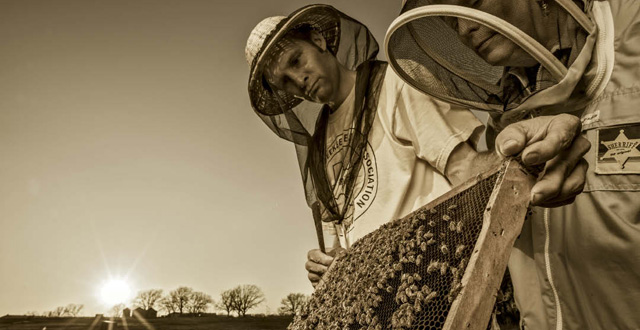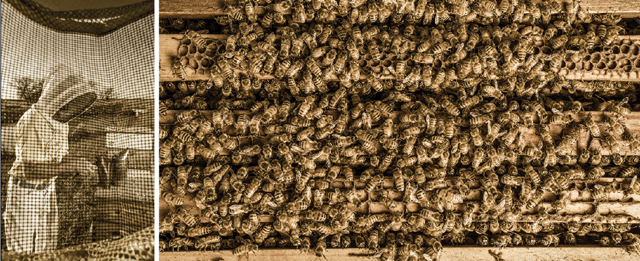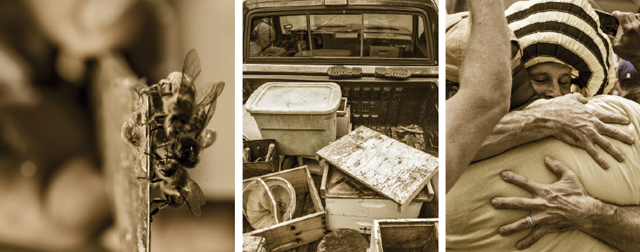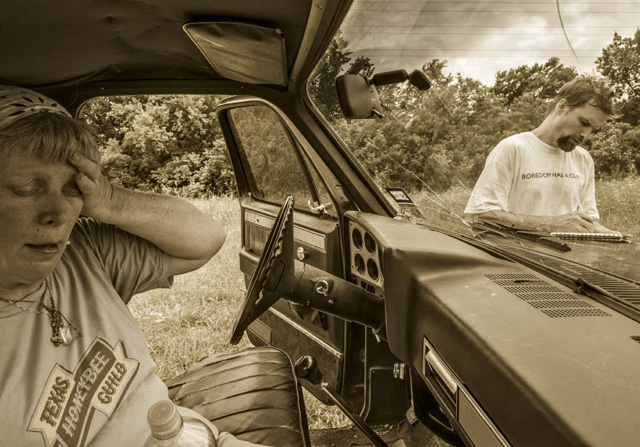Led by local apiculturists, Advocate photographer Danny Fulgencio looks at the lives of bees around Lake Highlands, their dwindling population and how it all impacts our lives.
Brandon and Susan Pollard herd honeybees. “Urban bee-wrangling,” they call it. Beyond being honey purveyors, the Pollards, via their Texas Honeybee Guild, save residential colonies from extermination, offer public education on the importance of bees and rally on their little charges’ behalf as environmental activists. As the Pollards often attest, bees are responsible for about 30 percent of our food. They pollinate more than 100 species of fruits and vegetables. Without them, we are in trouble. And that’s where we are headed, they say. In recent years, bee populations have been crushed by insecticides, disease, parasites and the enigmatic colony collapse disorder, a phenomenon that has caused the mysterious and widespread disappearance of worker bees. Last year proved especially brutal for the Pollards and their bees: The couple estimates they lost 60 percent of their hives, often after city-backed trucks and planes sprayed swaths of Dallas with neurotoxin to combat disease-carrying mosquitoes, which incidentally also threatens the humble bee. With mosquito season upon us, the Pollards attempt to rebuild their colonies while bracing for another possible round of chemical warfare.

HIVE CHECK The beekeepers inspect a frame of bees at the John Bunker Sands Wetland Center. The wetlands filter water from Dallas, which is then pumped back to the city. While honeybee colonies at the wetlands were not hit with neurotoxins during last year’s mosquito spraying, bees do drink water — and lots of it, the Pollards say, and when the water is toxic, they die.Photo by Danny Fulgencio

THE SMOKING HIVE Brandon Pollard lifts the lid off a hive at the Lake Highlands Community Garden. Smoke sedates the insects, Pollard says, because they are hardwired to conserve energy for flight when anticipating a hive fire. Bee smoking is an ancient practice — 15,000-year-old cave paintings show humans sedating bees with smoke. Photo by Danny Fulgencio

THROUGH THE BEEKEEPER’S HOOD (Above left) Brandon Pollard prepares a smoker to soothe a cluster of hives. The smoker is filled with shredded paper and herbs, including sage. He says that, while less consequential for working micro-apiaries, allowing a smoker to give out during this process would constitute “sacrilege.”
HIVE DEVELOPMENT (Above right) More than 60,000 bees can populate a colony. The Pollards keep several hives in Lake Highlands and dozens around Dallas. To combat the destruction of hives, the couple orders queen bees from a breeder near College Station, TX. The bees are shipped via UPS and used to split existing colonies. The purpose of hive-splitting is to maximize the foraging population. The Pollards hope it will help the bee population bounce back. Photo by Danny Fulgencio

HARDWARE-STORE HONEY Susan Pollard delivers honey to True Value’s Gecko Hardware in Lake Highlands. The eco-friendly store sells green products, including MosquitoDunks, regarded as a safer, more-surgical approach to killing mosquito larvae versus aerial spraying, which environmentalists say kill adult insects, bees included. Photo by Danny Fulgencio

MARCH AGAINST MONSANTO Protesters oppose Monsanto, bioengineers of agricultural chemicals. A thousand strong, protesters wind from City Hall toward the Farmers Market and back. Monsanto opponents blame the corporation, among others, for the drastic reduction of bee populations. The company has publicly denied that its products are the problem and has announced its intentions to help find a solution. Photo by Danny Fulgencio

BEE TRIO (Above right) Taken at the Lake Highlands Community Garden, a threesome gathers on a hive tool, used for beekeeping. Native Americans called them “white man’s flies.” Today they pollinate 30 percent of our food, or one of three bites, according to apiculturists.
BEEKEEPER GEAR (Above center) Aside from the heavy suits, beekeeping requires a load of gear and a pickup with which to haul it all.
SWEET GREET (Above left) Brandon Pollard embraces a fellow bee enthusiast at the previously pictured protest. Brandon hugs often. Big burly hugs. Often with his eyes closed. As the crowd thins, Brandon shakes his head, laments the lack of media presence and says, with a sad smile, “Preaching to the choir. Preaching to the choir.” Photo by Danny Fulgencio






